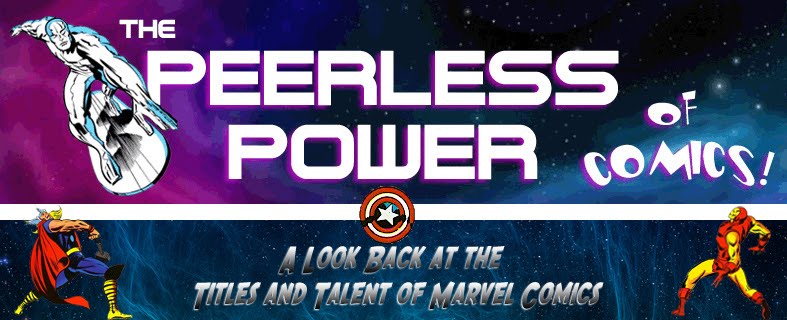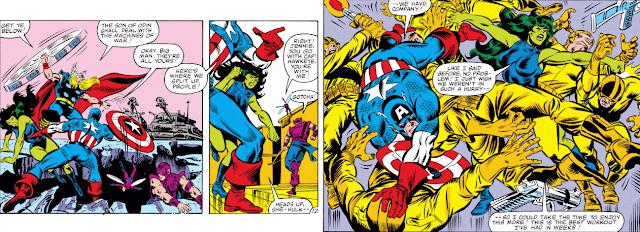Since we've recently seen an example of precision teamwork with the Fantastic Four, we should give equal time to the Avengers, who are no slouches in that department either--at least when they're allowed to work as a team. With each of these groups, we depend on the books' writers to have all of the characters operate as a unit--yet in most cases, they prefer to have team members take on a threat one-on-one, perhaps to give the villain du jour their due. But with the team's name emblazoned on the book's masthead, it stands to reason that readers are plunking down change to see that team at its best, with all of its members working together. After all, why read a team book if it's only a rare day when you see teamwork in play?
Following the period of issues which saw Henry Pym expelled from their ranks in disgrace and then branded as a criminal by the machinations of Egghead and the Masters of Evil, the Avengers have finally put their house in order. The Wasp has nominated herself for and been voted in as Chairwoman; the She-Hulk has become a member, with Hawkeye returning to the team as well; and the new Captain Marvel is operating with the team as an Avenger-in-training. There is still the matter of Iron Man's continued absences from meetings and calls to assemble, with Tony Stark suspected of having relapsed to a state of insobriety--but in a 1983 story written by Roger Stern, we mostly see an Avengers team back on track, tackling a high-stakes mission by the numbers and showing how effective they can be as a well-balanced, diverse lineup where its members truly function as part of the whole.
We get a glimpse of the threat the Avengers will face when unliving creatures emerge from Chesapeake Bay and silently invade a S.H.I.E.L.D. base near Baltimore, taking the forms of its agents after incapacitating them. As for the Avengers, their first scene has them observing a solemn moment, as they mourn the passing of a comrade they unfortunately never came to know.
There are a few things one could note in Stern's individual treatment of the mourners. For instance, I don't know if I would ever call the Vision's thoughts "tortured" as a rule, and certainly not at this point in time; there have been times when they've indeed been so, yes, but I think "brooding" might be closer to the general mark. Even in such a setting as we see here, it's difficult to fathom why his thoughts would be tortured about Jocasta. And while the Wasp's description is technically accurate, since it was her life force that Ultron used to animate Jocasta, I never once had the impression that she felt toward Jocasta as a sister. But Stern applies fair narrative to nearly everyone else--particularly Captain America, whose posture and expression are that of respectful stoicism, while Thor's musings are as noble as himself. (The She-Hulk and the Scarlet Witch mostly get a pass, which is regrettable.)
When the Avengers meet back at the mansion, the subject of Iron Man can't help but come up, since he's part of the active Avengers lineup and has been M.I.A. too often to simply ignore. But a call on their priority line puts that matter to rest, if disturbingly.
At this point in time, Stark has relinquished his identity as Iron Man to his close friend, James Rhodes--and it's Rhodes who's placed this call, which accounts for the moments where he appears to have been caught off-guard by comments from both Cap and the Wasp. The scene is also altered in Marvel's digital copy to correct an error by colorist Christie Scheele, who in the print copy gave Iron Man's hands a dark brown tint (Rhodes is an African-American), even over his metal gloves.
It seems that the Avengers won't be allowed to get too far in their deliberations* regarding the nomination of a new member, thanks to the escalation of the SHIELD situation--made even more serious by the arrival of Nick Fury at the base, as he escorts the President as part of an inspection tour. Both men don't yet realize that they've walked right into a deadly trap.
*At least on panel--but the story will have a surprise development later in that regard.
It's apparent in these Avengers stories drawn by artist Al Milgrom that Milgrom has a sense of what Stern is looking for in the depictions of the individual Avengers. For instance, the She-Hulk adds little to the team that either Thor or Iron Man couldn't supply in terms of sheer power; but Stern has emphasized both her volatile nature and her outgoing personality, as well as an eagerness for action combined with a confidence to meet whatever threat awaits with the intent to deal with it decisively. You'll see examples of that throughout this story, as well as such observations in other characters Stern wishes to emphasize. A good example would be the Wasp and Captain America, who Stern treats almost as co-leaders but defers to the Wasp when a final decision is called for. Cap is too valuable a resource as both a fighter and strategist as well as a team motivator not to allow him every opportunity to express himself; and while Milgrom gives prominent exposure to Cap, Stern blends in his style with the leadership of the Wasp to create a solid core which the others can rally behind.
Both Stern and Milgrom are on the same page regarding Captain Marvel, as well, as Stern continues to increase her responsibilities within the Avengers. In this case, she makes the perfect member to infiltrate and reconnoiter the SHIELD base, reporting back with crucial information which the team will need to plan its assault with both the enemy and its hostages in mind.
It's assumed that Fury doesn't yet know the nature of the base's captors, since that's certainly information he would have felt Captain Marvel should have. That might or might not make a difference when the Avengers have legs on the ground--we'll have to see how things play out. (And even a well-honed story should have a surprise or two that the heroes didn't see coming.)
Fury's idea to pull an Entebbe-style raid refers to the 1976 Israeli operation where an Air France plane was hijacked by Palestinian and German revolutionary members and diverted to the Entebbe airport in Uganda, where the hijackers gained the support of the country's dictator, Idi Amin. The Israeli forces invaded by night in a well-planned, swift operation that took into account armed resistance from Ugandan troops, and was by any measure a success, with all but three of the 106 hostages being rescued and all of the hijackers (including 45 Ugandan soldiers) killed, with one casualty (the unit's commander). Obviously the Avengers are going to have to proceed on several fronts to pull off such a raid--and proceed quickly, as Cap has already noted.
The villain in this story is one who's appeared recently, escaping from prison thanks to a mysterious benefactor that has supplied him with equipment which complements his own natural power. Given his demands of the government, he's obviously after wealth; in fact, if his costume didn't make him so recognizable, he'd be a good candidate as a PPC mystery villain. Knowing his identity would give the Avengers a considerable advantage going in--but as things stand, they'll have to rely on their efficiency and their abilities as they begin their assault. And for that, both Stern and Milgrom give us a page-turner display.
Meanwhile, Captain Marvel has rejoined Fury, in order to help protect the President if things go sour; while above and elsewhere, the Avengers have discovered that the surprisingly resilient "agents" they battle are made up entirely of insensible wood, allowing them to become more aggressive in their efforts to bring this conflict to an end. And as the battle's outcome becomes less certain for him, our villain is finally revealed: the Plant-Man, who now prepares a way to pull victory from possible defeat.
The Wasp has cleverly added the recovering SHIELD agents to the Avengers' forces by employing the shirts-and-skins method used by informal sports teams, which in this case will distinguish the real agents from their wooden counterparts. (We'll have to assume Hawkeye has found a moment to brief her on the true nature of the others; otherwise there's no reason for her to take such an approach.) Elsewhere, the safety of the President appears to indeed be at risk--but once the situation is resolved, things seem to be falling into place for the Avengers' operation, just as the Plant-Man unleashes his ultimate weapon.
A nice touch by Stern and Milgrom, having Cap remain behind with the President, doing the job which he would naturally consider to be the highest priority. And just look at how the other Avengers are enjoying their jobs when they're cooking on all cylinders.
Thanks to the last-minute arrival of Eros of Titan, whose ship destroys the leviathan, SHIELD and the Avengers mop things up and secure the base--while the Avengers join in congratulating the performance of their newest member, whose formal status it looks like they'd managed to vote on prior to setting out on this mission. The Plant-Man would escape in his undersea craft, though he's captured in short order by a joint Avengers/Navy operation in the next issue.
With Captain Marvel's new status as an active Avenger, and Eros taking her place as an Avenger-in-training, the team is back to its six-member lineup, since Hawkeye is forced to place himself on inactive status due to a broken leg suffered during the rampage of the Plant-Man's leviathan. But with Stern's run on the title just getting started, there are many changes ahead for the team--accent on "the team."
 | The Avengers #231 Script: Roger Stern Pencils: Al Milgrom Inks: Joe Sinnott Letterer: Jim Novak |

















4 comments:
As much as Marvel may be trying to push the rebranded Carol Danvers as a big name and kind of feminist face of their universe, I can't help but think they already had a pretty impressive character in this previous Captain Marvel. The more you've shown of Monica in recent blog posts, the more I think it's a pity they kinda-sorta threw her under a bus, rather than do more with her. Jokey Nextwave appearances besides.
(If Jen and Monica are talking between themselves about a tree-man, does that still fail the bechdel test?)
I'm getting a kick out of the mobilisation of the team - "It's the hotline! The president's in trouble - blast off!" And you're absolutely right about the theme of this post: the teamwork on display practically sparkles.
I suppose, Warren, that Monica may have been too powerful a character to carry the name of Captain Marvel to a series of her own (and, by extension, to such profits as Marvel hopes to see for a character named Captain Marvel), which might help to explain why the rug was pulled out from under her while her identity was still catching on. I truly dislike seeing a character so expertly handled and developed be discarded in such a way; one has to hope that there was some business-related reason behind it, since there appears to be no sense to it otherwise.
I agree with Warren. I really liked Captain (Monica) Marvel as written by Stern. Strong, smart, level headed, respectful of the more experienced Avengers and willing to learn from them. I also love when a creative team shows a superhero team actually fighting as a team! Chris Claremont is another one very good at this.
I never understood the terrible treatment of her character either. The Druid storyline which destroyed her sucks.
Post a Comment